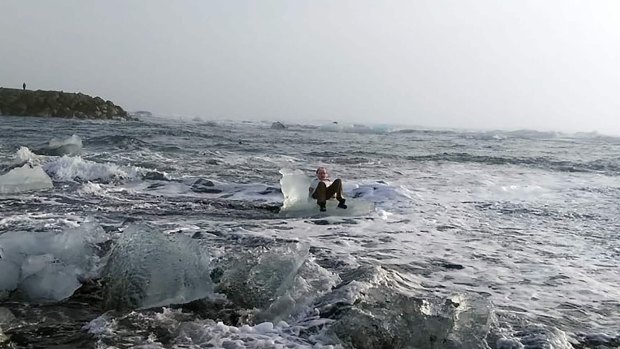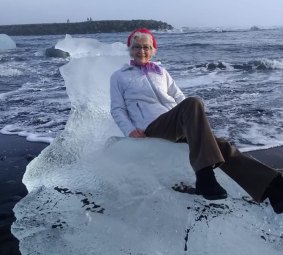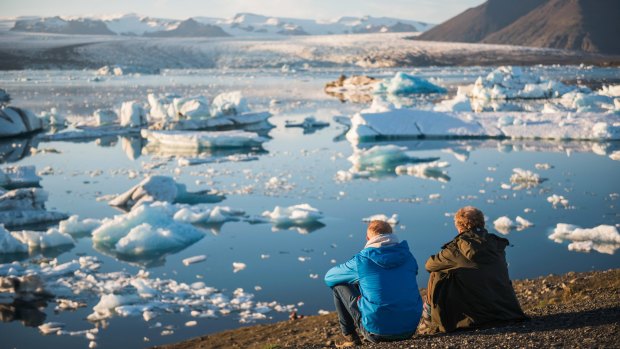This was published 5 years ago
Jökulsárlón glacier lagoon, Iceland: Woman drifts out to sea after posing for photo on 'ice throne'

Judith Streng was posing on the ice for a photo.Credit: TWITTER/XIUSHOOK
A tourist who posed for a photo on an "ice throne" in Iceland had to be rescued after she starting drifting out to sea in freezing temperatures.
Judith Streng was travelling with her son, Rod, and a guide, when she sat on a small chunk of ice shaped like a throne at Jökulsárlón glacier lagoon, but a wave dislodged the floe from the shore and she floated into the Atlantic.
The grandmother from Texas was rescued by a fellow American, Randy Lacount, a boat captain from Florida, who waded into the water and helped her down.

Judith Streng on the 'ice throne'.Credit: TWITTER/XIUSHOOK
Speaking to ABC News, Streng said: "It was shaped like an easy place to sit. You can tell by looking at the shape of it, and I thought well it looks like fun.
"When I got on it, it started to totter and a wave was coming in. A very large wave came in and kind of made the throne kind of rock, and I could tell that I was slipping off."
In texts posted on a Streng family Whatsapp group, and published on Twitter, one member called her an "iceberg queen… [that] lost her kingdom when she drifted out to see [sic]".

Jökulsárlón glacier lagoon.Credit: Alamy
Streng said a number of others had posed before she did and she "thought it was safe".
"One girl had been on it and then two girls at the same time, and it was very secure with them. But I don't weigh very much. So it was a little easier to float off with me, I guess," she said.
Jökulsárlón glacier lagoon, where chunks of ice break off from the Vatnajökull glacier and float out to sea, is one of Iceland's most popular tourist attractions and also cited as one of the most dangerous.
In 2015, warning signs were put in place after a female tourist was struck and killed by an amphibious tour vehicle. In 2016, police issued a warning to visitors not to walk out across the ice, which can be unstable and easily break apart.
"Although the ice may be connected to land when you arrive, and looks safe to walk on, it can easily break off from the land," writes Nanna Gunnarsdóttir, from the Guide to Iceland website.
"If you find yourself stranded on a block of ice in the lagoon, you're in serious danger since the ice can tip over - meaning you'd fall into the ice cold water, or might even get trapped underneath the iceberg itself. The water is so cold that people can only stay in it for a few minutes before they'd get hypothermia and die, and the current in the calm lagoon is strong and can easily carry people out to sea.
"Again, people tend to misjudge how stable and safe the natural attractions in Iceland are, that can lead to fatal incidents."
A surge in the number of visitors to Iceland in recent years has led to concern from authorities that travellers are increasingly putting themselves at risk.
In 2016 the tourist board launched a course on how to stay safe in the country, with a spokesperson at the time saying: "The majority of tourists want to experience nature, and we know that Icelandic nature must be treated with respect and care."
In 2017, the tourism ministry launched the Icelandic Pledge calling on visitors to be responsible.
Iceland's Tourism Minister Þórdís Kolbrún R. Gylfadóttir said at the time: "The type of people who come to Iceland want to be responsible tourists, it's just that they aren't always aware of what that entails. So as part of our welcome, we wanted to create a pledge which we'll encourage all visitors to take, creating an army of people who know how to stay safe and also how to look after our delicate nature."
The Icelandic Pledge is a voluntary scheme – not part of national law - and reads: "I pledge to be a responsible tourist. When I explore new places, I will leave them as I found them. I will take photos to die for, without dying for them. I will follow the road into the unknown but never venture off the road. And I will only park where I am supposed to. When I sleep out under the stars, I'll stay within the campsite. And when nature calls, I won't answer the call on nature. I will be prepared for all weathers, all possibilities and all adventures."
The south coast - where most holidaymakers congregate - has some of the country's most dangerous beaches, with the black beach of Reynisfjara the site of a number of deaths due to unpredictable waves and strong currents.
The Telegraph, London
See also: The country where travellers outnumber locals five to one
Sign up for the Traveller newsletter
The latest travel news, tips and inspiration delivered to your inbox. Sign up now.